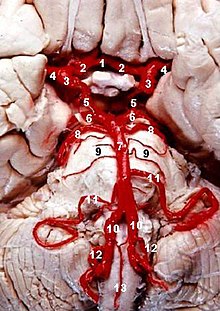Medial Pontine Syndrome

Medial inferior pontine syndrome is a condition associated with a contralateral hemiplegia.
"Medial inferior pontine syndrome" has been described as equivalent to Foville's syndrome.
Presentation
Although medial pontine syndrome has many similarities to medial medullary syndrome, because it is located higher up the brainstem in the pons, it affects a different set of cranial nuclei.
| Structure affected | Presentation |
|---|---|
| Corticospinal tract | Contralateral spastic hemiparesis |
| Medial lemniscus | Contralateral PCML (aka DCML) pathway loss (tactile, vibration, and stereognosis) |
| Abducens nerve | Strabismus (ipsilateral lateral rectus muscle paralysis - the affected eye looks down and towards the nose). Abducens nerve lesion localizes the lesion to inferior pons. |
Depending upon the size of the infarct, it can also involve the facial nerve.
Cause

Human brainstem blood supply description. Basilar artery is #7, and pons is visible below it.
Medial pontine syndrome results from occlusion of paramedian branches of the basilar artery.
Diagnosis
Treatment
See also
- Alternating hemiplegia of childhood
- Lateral medullary syndrome
- Lateral pontine syndrome
- Medial medullary syndrome
- Weber's syndrome